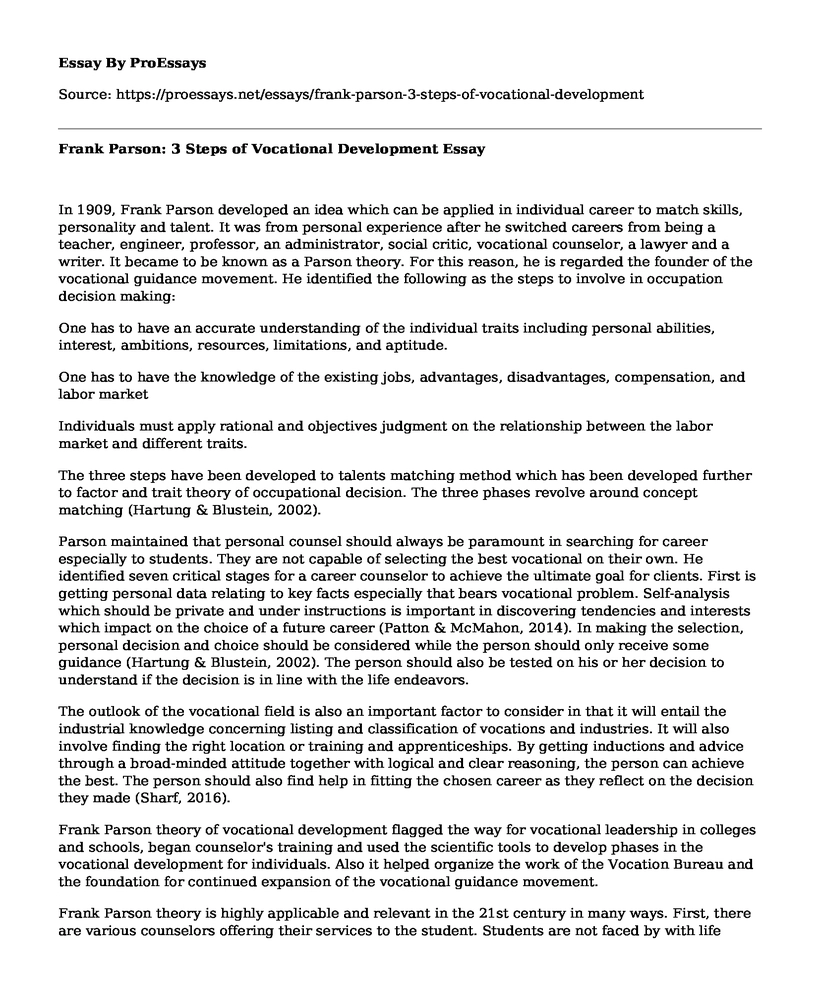In 1909, Frank Parson developed an idea which can be applied in individual career to match skills, personality and talent. It was from personal experience after he switched careers from being a teacher, engineer, professor, an administrator, social critic, vocational counselor, a lawyer and a writer. It became to be known as a Parson theory. For this reason, he is regarded the founder of the vocational guidance movement. He identified the following as the steps to involve in occupation decision making:
One has to have an accurate understanding of the individual traits including personal abilities, interest, ambitions, resources, limitations, and aptitude.
One has to have the knowledge of the existing jobs, advantages, disadvantages, compensation, and labor market
Individuals must apply rational and objectives judgment on the relationship between the labor market and different traits.
The three steps have been developed to talents matching method which has been developed further to factor and trait theory of occupational decision. The three phases revolve around concept matching (Hartung & Blustein, 2002).
Parson maintained that personal counsel should always be paramount in searching for career especially to students. They are not capable of selecting the best vocational on their own. He identified seven critical stages for a career counselor to achieve the ultimate goal for clients. First is getting personal data relating to key facts especially that bears vocational problem. Self-analysis which should be private and under instructions is important in discovering tendencies and interests which impact on the choice of a future career (Patton & McMahon, 2014). In making the selection, personal decision and choice should be considered while the person should only receive some guidance (Hartung & Blustein, 2002). The person should also be tested on his or her decision to understand if the decision is in line with the life endeavors.
The outlook of the vocational field is also an important factor to consider in that it will entail the industrial knowledge concerning listing and classification of vocations and industries. It will also involve finding the right location or training and apprenticeships. By getting inductions and advice through a broad-minded attitude together with logical and clear reasoning, the person can achieve the best. The person should also find help in fitting the chosen career as they reflect on the decision they made (Sharf, 2016).
Frank Parson theory of vocational development flagged the way for vocational leadership in colleges and schools, began counselor's training and used the scientific tools to develop phases in the vocational development for individuals. Also it helped organize the work of the Vocation Bureau and the foundation for continued expansion of the vocational guidance movement.
Frank Parson theory is highly applicable and relevant in the 21st century in many ways. First, there are various counselors offering their services to the student. Students are not faced by with life dilemma and can utilize their time in a better way. View career decisions as values-based decisions. Offer counseling-based career assistance has been highly embraced by many individuals through its development by various theoretical scientists (Krumboltz & Henderson, 2002). Persons theory can currently provide multicultural career interventions and help people focus on multiple life roles.
In the 21st century, Parson three steps of vocational development are being used to solve global unemployment by assisting the employee in identify the right career which has more opportunities, conditions of success, advantages and compensation. Corporates use it to downsize in the event of layer-off. More people can now work from home, have dual careers, intertwine between family and work roles, have different job shifts and develop their lifelong education (Sharf, 2016). However, this has been enabled by various scientific development on the theory over time.
References
Krumboltz, J. D., & Henderson, S. J. (2002). A learning theory for career counselors. Adult career development: Concepts, issues and practices, 41-58.
Patton, W., & McMahon, M. (2014). Career development and systems theory: Connecting theory and practice (Vol. 2). Springer.
Sharf, R. S. (2016). Applying career development theory to counseling. Cengage Learning.
Hartung, P. J., & Blustein, D. L. (2002). Reason, Intuition, and Social Justice: Elaborating on Parsons's Career DecisionMaking Model. Journal of Counseling & Development, 80(1), 41-47.
Cite this page
Frank Parson: 3 Steps of Vocational Development. (2021, Apr 02). Retrieved from https://proessays.net/essays/frank-parson-3-steps-of-vocational-development
If you are the original author of this essay and no longer wish to have it published on the ProEssays website, please click below to request its removal:
- Essay Example on Performance-Based Budgeting
- Students Behavior and Progress Management - Essay Sample on Teaching
- Public Employment Agencies Essay
- Social Development Case Study
- Single-Family Students Essay Example
- Application for the Aviation Scholarship
- Essay Sample on Trigger Warnings: Pressure on Students in Education Centers







